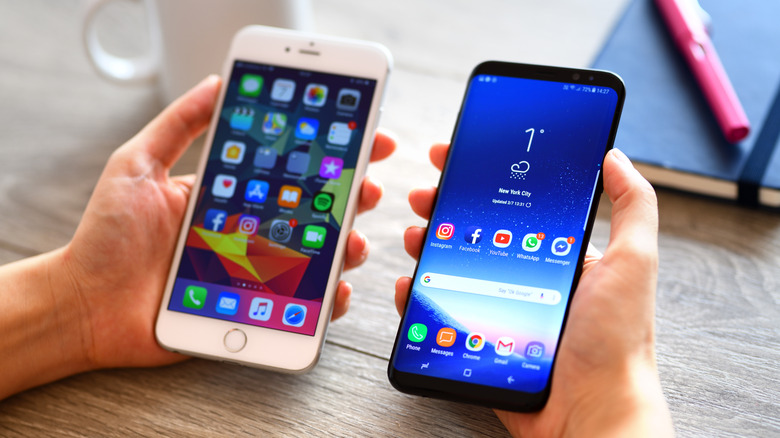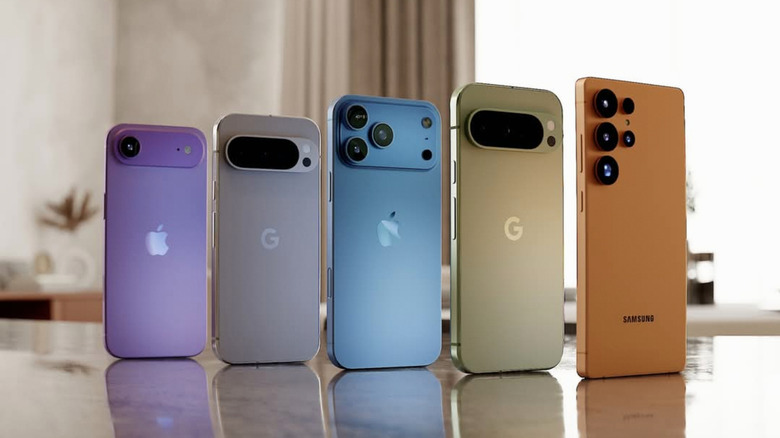You Can Run iOS Apps On Android Phones - Here's How
Though the battle between Android and iPhone has been long and bitter for many, especially for Apple and Google, one team of developers is looking to instill a sense of harmony with an iPhone and iOS emulator for Android and other devices. Though some rather notable limitations of the emulator likely won't make anyone switch from iPhone to Android anytime soon, the project shows a lot of promise in terms of bringing new life to some potentially long-forgotten iPhone apps.
The open source iOS emulator touchHLE is available for anyone who's always trying to get the best of both worlds. At the time of this writing, the emulator only works with a small selection of programs from an earlier era of iPhone's history, and certain restrictions also prevent the developers from handling the iOS versions that adopted 64-bit technology. Nonetheless, anyone who has always felt that iPhone apps are better than Android apps may get a kick out of touchHLE.
The emulator can be a great way to explore the early days of the iPhone, making it an app worth considering for anyone who pines for the days of classic games like "Castle Smasher," "I Love Katamari," and "Metal Gear Solid Touch." Though it may not give you the same experience as running Steam games on your Android phone, it's sure to bring a few moments of old iPhone nostalgia.
Is it possible to use iOS on Android?
It's possible to run iOS apps and games on Android, but it's going to be a bumpy ride. Available for Android, Windows, and macOS, touchHLE is an iPhone operating system emulator capable of running iPhone and iPod touch apps from the iPhone OS 2.x and 3.0 era, which ended around 2011.
The developers behind touchHLE have long-term plans to bring functionality for iPhone OS 3.1, iPad apps with iPhone OS 3.2, and iPhone OS 4.x apps. Unfortunately, don't expect touchHLE to run any modern iOS apps anytime soon, if ever. According to the developers, it's likely that the emulator will only ever support 32-bit apps, as making something that supports both 32-bit and 64-bit may be too difficult for the team. Since iOS adopted its first 64-bit chipset with the Apple A7, don't expect apps beyond iPhone OS 6 anytime soon.
Keeping this in mind, you may have some trouble running most applications and games. Nonetheless, the developers do keep a database of compatible apps for touchHLE, with the list even providing a rating of how well the apps function within the emulator. Since the developing team is a group of volunteers, you may be waiting a while to see this list expand and use touchHLE to run newer iOS versions.
How to install touchHLE
Before you can install touchHLE on your Android, make sure that Allow Unknown Apps is enabled on your device. Here are the approximate steps:
-
Open your Settings app.
-
Choose Apps, or Apps & Notifications on some devices.
-
Select the three dots in the upper-right corner if they are there, or go to the next step.
-
Select Special access, or Special app access in some cases.
-
Choose Install unknown apps.
-
Select your favorite web browser.
-
Ensure that Allow from this source is enabled.
From here, get ready to extract the touchHLE ZIP file on your Android. This will require a File Manager. If your device doesn't have one or you're unsure, Files by Google is available through the Google Play Store, should you need it. You can then begin extracting and installing touchHLE.
-
Download the latest release of touchHLE through GitHub.
-
Open your file manager.
-
Locate the touchHLE ZIP file. It will likely be in your Downloads folder.
-
Select the touchHLE ZIP file.
-
Tap Extract and check the path where the extracted files will be available.
-
Locate the extracted APK file.
-
Select it and choose Install.
Once this is done, you will need to ensure that any iOS IPA files, which are the files that contain iOS apps, are within the touchHLE_apps directory. When you have the IPA file, use your file manager to copy it to the android/data/org.touchHLE/files/touchHLE-apps directory. As the developers of touchHLE note, you may have some issues with file management due to certain Google restrictions. You may need to consult touchHLA's GitHub for Android page for further solutions.


